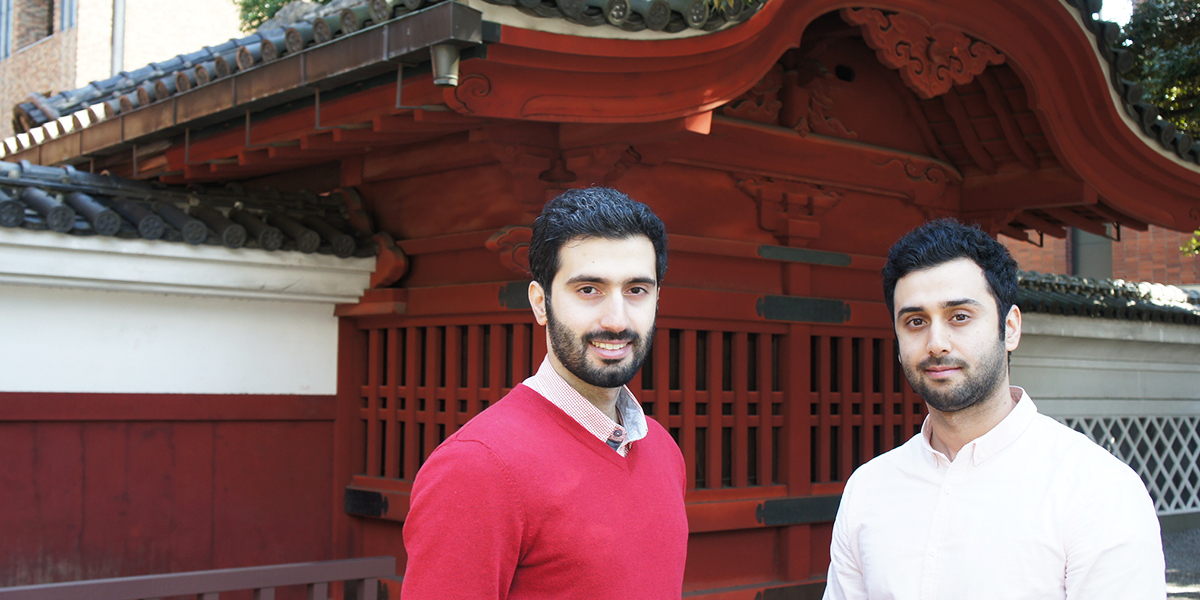
The Bonds of Brotherhood Accelerate Autonomous Driving and Bridge the Gap between Iran and Japan
-
- Ehsan and Mahdi Javanmardi
- Doctoral degree students, Graduate School of Information Science and Technology (IST)
Area of research: Information and communication engineering
Country/Region of Origin: Iran
Putting our Childhood Experiences in Japan to Use
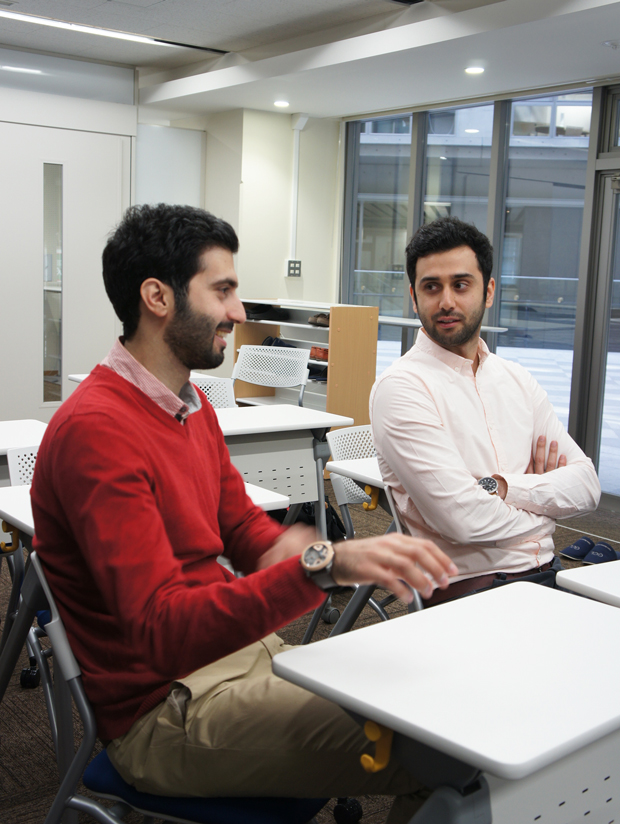
Ehsan and Mahdi spent their childhood in Fukuoka, Japan for eight years as their father studied at Kyushu University. They soon acclimated to their new life in Japan, and formed a unique view of their relationship with the country based on their backgrounds and experiences.
We decided not to become “Japanese”
Mahdi: When we stayed in Japan, our family moved around a lot, and I changed elementary schools three times. At the first two schools, I had a rather difficult time in communicating with my Japanese classmates. By the time I had transferred to the third school, however, I had become used to Japanese schools and was able to make many friends, partly because I also joined a local kids' baseball team.
Ehsan: I didn't have any problems communicating with the other kids. At elementary schools, being good at sports or being funny tends to make you popular. Since I was good at soccer and baseball, I was able to make many friends through sports activities. Also, as I was older than Mahdi, I was a little craftier in how I approached social situations. For instance, I strategically aimed to be "number two" at things because more people will try to compete with you if you're "number one" (laughs).
Our policy was that if you want to live happily in Japan as someone who comes from overseas, you should not become "Japanese." If you do, you will end up having stressful experiences. Instead of becoming Japanese and acting like Japanese people, we decided to keep our proud Iranian culture while respecting the Japanese who also have a distinctive culture. Our stance was that we are not Japanese but Iranians, so let's become friends and respect each other. Thanks to this policy, we were able to stay positive about our childhood experiences.
M: While adults tend to be more respectful of cultural differences, many children are not mature enough to do so. That's why we had to deal with these circumstances.
Choosing Japan
E: After staying in Japan for eight years, we went back to Iran. I got my Bachelor's and Master's degrees from Amirkabir University of Technology in Iran. I decided to study computer engineering first, and then Mahdi did the same.
M: I also got my Bachelor's degree in computer engineering from Shahid-Beheshti University, and my Master's degree in the same subject from Sharif University of Technology. When I started looking for a university to get my PhD at, my father advised me to study abroad to gain more experience. One of my choices was Japan. I wanted to try living in Japan again as an adult because there were a lot of things that I did not understand from my experience growing up there. I was also considering studying in the U.S., but my first acceptance letter came from the University of Tokyo. Seeing the acceptance letter made me think, "Well, it's Japan, plus it's UTokyo, so that sounds pretty good to me!" That's when I made up my mind to come to Japan.
E: At first, I also thought about studying in the U.S., Europe, or Japan. I eventually opted for Japan because I did not want my childhood experiences in Japan to go to waste. For example, when I join a company or start my own company, people are going to ask me things like "How does Japan's economy work?" or "What did you do in Japan?" With only my childhood memories to look back on, my answers would be something like "I played dodgeball and soccer with other kids." (laughs) If I live in Japan for several years as an adult, I can have a more precise grasp of Japan, including Japan's economy. If I can communicate to Iranians more realistic and practical information about Japan, it would be advantageous both to Iranians and Japanese. So, I thought I should go to Japan.
Setting foot again on Japanese soil
E: I applied for a MEXT scholarship in 2013. I wanted to research wireless sensor network systems at UTokyo, Japan's top university, and contacted two laboratories that I thought would be the best places to do this kind of research. Unfortunately, I was not accepted into either laboratory, so I declined the scholarship. A staff member of the Japanese embassy in Iran was surprised because no one had ever declined a scholarship offer from MEXT. I decided to reapply for the same scholarship in 2014, this time together with Mahdi.
M: We heard from someone that MEXT would not accept two people from the same family at the same time, and Ehsan declined a MEXT scholarship in the previous year. So, he thought he would not get it. But both of us ended up being accepted! I was extremely happy.
E: I was really happy, too. Receiving a scholarship made me happy enough, but what made me happier was that I would come to Japan with my younger brother who also received the same scholarship. Family always comes first for me.
M: In fact, my favorite kanji is 父 (chichi; father). It looks like two swords crossing, which is cool.
E: Mine is 愛 (ai; love).
Brothers Researching Self-driving Technologies
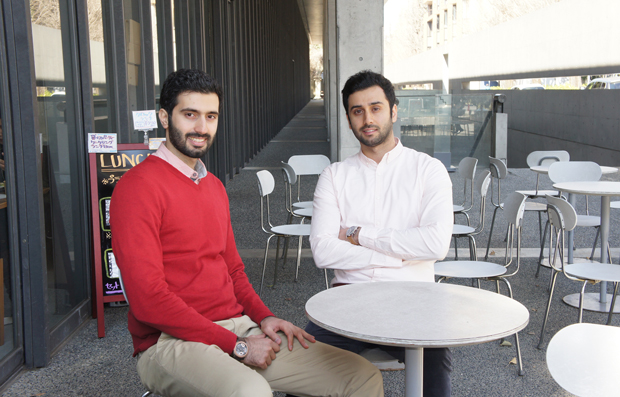
Ehsan and Mahdi came to Japan together and enrolled in the Department of Information and Communication Engineering of the Graduate School of Information Science and Technology (IST), the University of Tokyo. They are now members of the Kamijo Laboratory on the Komaba Research Campus and research autonomous driving technologies.
Our brotherly bond makes us stronger
E: Kamijo Laboratory offers a truly international environment; 80% of its members are not Japanese. At the lab, we usually communicate in English. At home, Mahdi and I speak in Persian. The only opportunities for us to speak Japanese, excluding very short exchanges with shop clerks, are when we talk with IST's staff (Sato-san and Shiraishi-san) who are extremely nice and helpful. Even though we speak Japanese fluently, I feel like we should maybe start taking Japanese language classes just to keep our Japanese up! (laughs)
M: I am working on 3D map generation and correction methods, which are indispensable in running autonomous vehicles. In our experiments, we drive a regular car with various sensors, such as laser scanners and very high-precision GPS equipment, in real streets to collect data. Using software that I have developed, that data is configured into 3D maps. Ehsan researches how self-driving cars utilize those 3D maps to determine their locations.
E: Basically, I take what Mahdi makes and put it to use towards our goal of realizing full-fledged autonomous driving.
M: It's very convenient to be doing similar research with my brother like this. Our brotherly bond makes us stronger.
E: When Mahdi and I cooperate, we have the combined power of 3.5 people. On my own, even if I'm doing my best, my strength can become only 1.2 or 1.3 times higher at most. Also, we can save time on research-related activities this way. For example, if I am too busy with research to attend a meeting, I can ask Mahdi to go to the meeting and hear from him about it later. As we have been together since childhood, he just has to say a few words for me to understand what was discussed at the meeting. This is a very attractive "family discount plan" (laughs).
The promising future of autonomous driving
M: The first step for realizing human-like driving is to enable an autonomous car to precisely monitor its surroundings. GPS used in smartphones cannot offer precise information when surrounded by high buildings, so it is unsuitable for autonomous cars. It's important for self-driving cars to move based on correct information. Another issue is how humans and autonomous cars relate to each other. Without cues, such as eye contact from a driver, pedestrians may not be able to predict how an autonomous car will behave. Accordingly, both the car and the pedestrians will not know what they should do next.
E: We try to solve these issues with artificial intelligence. The point is that we should achieve human-like self-driving cars by allowing autonomous cars to predict the behavior of surrounding cars and people, instead of making them stop whenever they encounter humans or cars.
M: What we are trying to achieve now is self-driving technological capability that is equivalent to that of humans. Currently, autonomous cars are 70 to 80% of the way there. After we reach 100%, the next stage will be to surpass human beings. Even now, the probability that autonomous cars will cause accidents is extremely low. But that's just because they stop so often (laughs).
E: Our ultimate goal is for a driver to only need to input a destination, with the rest being automatically controlled by the car. This level of self-driving will lead to zero car accidents, energy-saving due to a reduction in redundant accelerating and stopping, and no traffic jams.
M: As autonomous driving has attracted attention from various fields, we feel that our research is worthwhile. However, this is quite a new area of study, and no consensus has been built for standard procedures. Take positioning sensors, for example. We have not yet decided which types of sensors are more ideal for obtaining the ego-position of autonomous vehicles. The one we have tried is a stereo camera, which is basically two cameras placed next to each other like human eyes. This type of camera can not only monitor surrounding objects but also measure the distances to objects. Another sensor we have tried is a "LIDAR" that measures distances to objects using laser light. Cameras do not work well at night, but LIDAR does.
E: The technology that uses different combinations of various sensors depending on circumstances is called "sensor fusion." The car's AI judges which sensor will be appropriate in a particular situation and decides to what extent and how this sensor should be used.
M: This autonomous vehicle that we have conducted various experiments with is equipped with 3D maps of only limited areas and with very limited types of sensors. A laptop computer functions as the brain of this vehicle. Nevertheless, the car still costs about 14,000,000 yen ($140,000). If we wanted to upgrade our LIDAR, that alone would cost millions of yen. We expect that as these components come to be mass-produced, their prices will go down.
Building Bridges between Iran and Japan
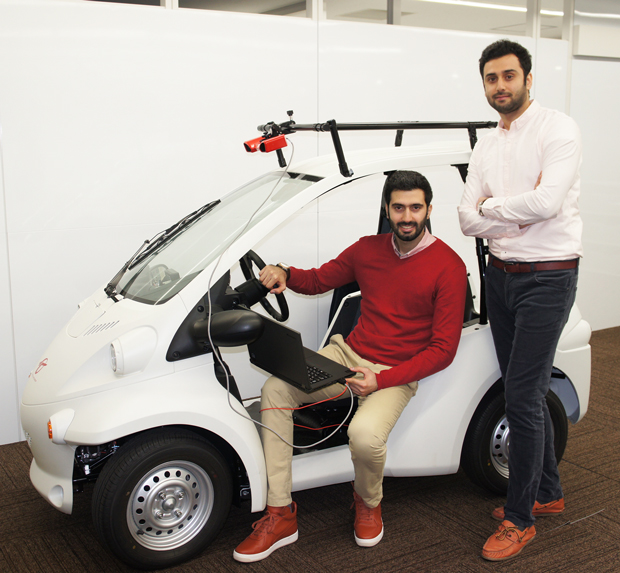 The brothers say that their car doesn't have a name yet. It would be great if you gave them some suggestions! They would like it if its name had something to do with an animal that could be associated with autonomous driving.
The brothers say that their car doesn't have a name yet. It would be great if you gave them some suggestions! They would like it if its name had something to do with an animal that could be associated with autonomous driving.
In addition to IST, Ehsan and Mahdi have also joined an interdisciplinary doctoral program called the Graduate Program for Social ICT Global Creative Leaders Program (GCL).
The appeal of University-industry cooperation
M: We also research autonomous driving in the GCL program. Through this program, we gained the opportunity to use this autonomous car prototype as a shared piece of experimental equipment, and we are going to do a six-month internship at a laboratory at UC Berkeley with which Professor Kamijo has conducted collaborative research.
E: Participating in the GCL program and acquiring leadership skills is a necessary step for realizing our future plan of becoming academic staff at an Iranian university and starting our own company at the same time. The GCL program is also very useful because it enables us to view self-driving from a wider perspective through discussion on a variety of issues related to autonomous driving, including insurance (Who should compensate for damage since a car is driven not by a human but by a machine?), legal problems, and ethical issues (Should cars be allowed to sacrifice one person in order to save three people?).
M: Thanks not only to participation in the GCL program but also to Professor Kamijo's connections, we can meet all kinds of people from Japanese companies. Sometimes we can even talk with executives. For young people like us, chances to talk to executive staff in Japanese companies are quite rare. So, this program offers us very good opportunities to learn about business. One of the advantages of studying in Japanese universities is that they often collaborate with industry. I want to learn as many good practices as possible from Japan and communicate them to people in Iran.
For Iran and for Japan
E: In the future, we want to contribute to the development of Iran. At the same time, it would be great if we could have a base in Japan.
M: I think it would be ideal if we could get concurrent positions at universities both in Japan and in Iran. We could do collaborative research and travel back and forth between the two countries.
E: My dream is for Mahdi and me to set up our own research center in Iran and communicate to Iranians what we have learned in Japan, including expertise in and technology of autonomous driving and the advantages of university-industry cooperation. I also want to export to Iran the virtues of the Japanese—for example, they are hardworking, meticulous about preparations, and willing to observe rules and follow orders. Iranians, on the other hand, tend to want to do everything their own way. (laughs)
M: I would like to give some advice to those who plan to study in Japan: please study Japanese before and after coming to Japan. I know you will be busy with research, but if you have a good command of Japanese, you can double or triple the amount you learn while you're in Japan.
E: I was going to say the same thing Mahdi said! As another piece of advice, I would say that if you come to Japan through a MEXT scholarship, please enjoy the first year as a research student. At first, I thought that one year as a research student would be a waste of my time because I wanted to enroll in a Doctoral degree program immediately. Looking back on it now, however, I realize that this experience was valuable for me because that first year was full of new discoveries about Japan.
Family is an Absolute Treasure
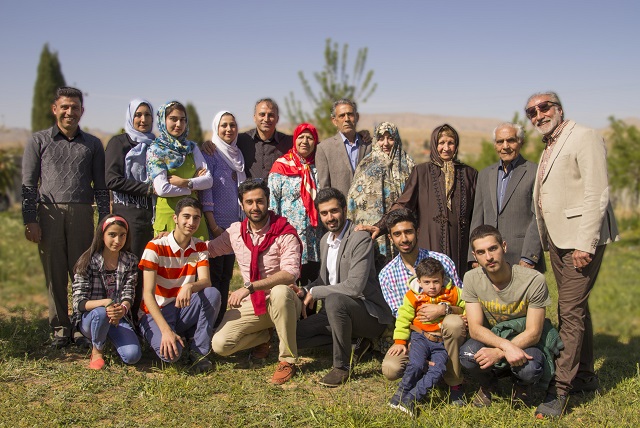 The brothers both returned to Iran for their well-deserved spring break. The picture is of the brothers and their family following a picnic just outside the city of Shiraz (the brothers' birthplace).
The brothers both returned to Iran for their well-deserved spring break. The picture is of the brothers and their family following a picnic just outside the city of Shiraz (the brothers' birthplace).
Even though Ehsan and Mahdi live in Japan, they continue to communicate with their family in Iran every day.
Is it unusual for brothers to be as close as we are?
M: Almost every Japanese person we meet says, "You guys are always together. You must be really close!" But for us, this is normal. It's not out of the ordinary in Iran at all.
E: As we get told this all the time, I sometimes think, "Are we really that close?" We're just talking with each other normally when people tell us that. I wonder what Japanese people would think if they came to our home in Iran. Every morning all the family members see our father off at the entrance by kissing him on the cheek. We do the same when he comes home, too.
M: Our father rings the doorbell when he comes home, and the way he does it is very unique. He rings it several times and holds down the doorbell button for a long time. It's as if he's saying, "It's me!" (laughs).
E: The time I like best at home in Iran is when we finish dinner around 9PM. We sit on the sofa and chat with our father over a cup of tea for a while.
M: We talk about a lot of things from what we did that day to politics and the economy.
Even though we’re far apart, we are still family
E: We often do video chats on the Internet with our dad. When we call him around 9PM, he is drinking tea and relaxing. He looks so content that it makes me want to go back to Iran and sit next to him (laughs).
M: Our family members in Iran miss us very much.
E: We also do video chats on the Internet with our mom every day. We talk for about 15 minutes about ordinary things like what we ate that day. We take turns talking with her—like maybe today, I'll talk with her, and tomorrow it'll be Mahdi's turn, or something like that. If we don't call her, she'll get lonely. We don't talk to her just on special occasions; it's just part of a normal day to us.
M: Our parents have loved and cared for us very much, so we naturally want to do the same for them. Even though we're far apart, we are still family. Family is everything to us.
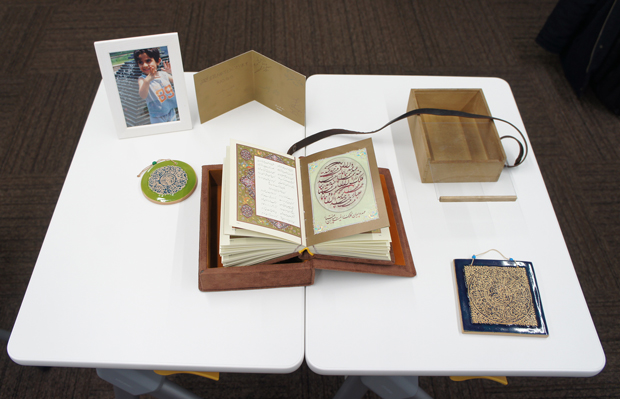
Keepsakes from Iran
Treasuring Friends, Family and Culture
Ehsan and Mahdi's love for their family and the rich literary culture of their home country of Iran can be seen in the beautiful mementos they showed us. The photograph is of their little brother, Sadjad, when he was much younger. Sadjad is currently a high school student, and wants to study engineering like his older brothers. The card and the leather bracelet were birthday presents to Mahdi from his friends before he left Iran to come to UTokyo. The bracelet is inscribed with a poem in Persian. Similarly, the two decorative tiles are inscribed with verses from the Quran. The book is a collection of poems by the famous Persian poet Hafez. The brothers turn to the poems in this leather-bound book with stunning illustrations whenever they are troubled or need advice about something. Although they are physically separated from Iran, the brothers' spiritual and emotional home clearly lies within their home country.
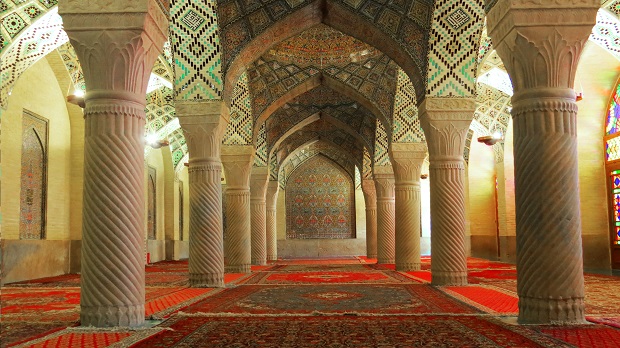 Nasir ol Molk Mosque in Shiraz, Iran
Nasir ol Molk Mosque in Shiraz, IranIran is Always on Their Minds
Iranian politics and the Iranians Association
In their spare time, Ehsan and Mahdi both enjoy reading about, researching and discussing the politics and economy of Iran as well as international issues. They say they're always reading up on the current trends in Iran even while they're in Japan. The brothers are also active in The University of Tokyo Iranians Association (TUTIA). Mahdi was the Association's first president, and the second (and current) president is Ehsan. Ehsan is so busy with his research, though, that he says he's already looking for a successor!





